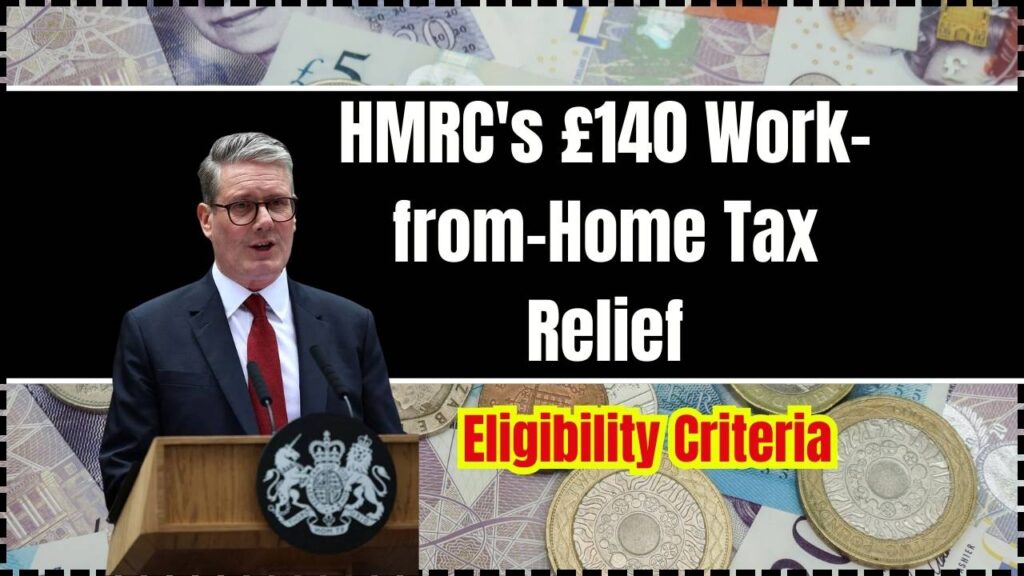
HMRC’s £140 Work-from-Home Tax Relief: If you’ve been working from home and covering extra household costs, you might be eligible for HMRC’s Working from Home Tax Relief—worth up to £140 per year. This comprehensive guide walks you through eligibility, how much you can claim, and how to apply. Written in plain English, it’s designed for everyone—from first-time claimants to seasoned professionals managing their finances. With more people working remotely than ever before, understanding your entitlements can help ease the financial load of homeworking.
HMRC’s £140 Work-from-Home Tax Relief
In today’s hybrid and remote-first work environments, it’s essential to understand what financial support you’re entitled to. HMRC’s Working from Home Tax Relief is a practical benefit that helps offset increased living costs for eligible employees. By knowing the rules, choosing the right claim method, and keeping your documentation in order, you can take advantage of up to £140 per year in tax relief. And with the ability to backdate up to four years, even those who missed out during the pandemic may still have time to claim.
| Feature | Details |
|---|---|
| Eligibility | Must be required to work from home; employer does not reimburse expenses |
| Claim Amount | £6/week flat rate or actual additional costs (with evidence) |
| Relief Value | Up to £62.40/year (basic rate) or £124.80/year (higher rate) |
| Claim Period | Current tax year and up to 4 previous years |
| Application Methods | Online HMRC portal, Self Assessment, or postal Form P87 |
| Evidence Required | If claiming actual costs: bills, employer confirmation of mandatory homeworking |
| Official Portal | HMRC Working from Home Tax Relief |
What Is HMRC’s Work-from-Home Tax Relief?
The Working from Home Tax Relief is a benefit offered by HM Revenue and Customs (HMRC) to help cover the increased household expenses that come from remote work. These expenses could include higher heating bills, electricity, metered water usage, and business-related phone calls.
Introduced more broadly during the COVID-19 pandemic, this relief continues to be available for those with valid remote working arrangements in 2025.
Who Is Eligible?
To qualify, you must meet all of the following conditions:
- You are required to work from home by your employer (not simply choosing to).
- You incur additional expenses because of working from home.
- Your employer does not reimburse you for these expenses.
Common eligible scenarios:
- Your company closed its office.
- Your role is location-independent (e.g., field-based jobs).
- Government rules or company policy mandate homeworking.
You are not eligible if:
- You chose to work from home for convenience.
- You split time between home and office voluntarily.
- Your employer reimburses your homeworking costs.
Even if you’re using a spare room or working from your kitchen table, if your employer requires you to be at home and you’re paying more as a result, you may qualify.
How Much Can You Claim?
HMRC gives you two options for claiming:
1. Flat Rate (No Evidence Required)
- £6 per week (standard rate set by HMRC)
- Tax relief equals:
- £62.40/year for basic rate taxpayers (20%)
- £124.80/year for higher rate taxpayers (40%)
2. Actual Costs (Evidence Required)
You can claim more than £6/week, but you’ll need to prove the additional expenses with:
- Bills showing increased costs
- A reasonable method for splitting business vs. personal use
This method may be better for households with significant utility cost increases, though it takes more effort and documentation.
How to Claim the HMRC’s £140 Work-from-Home Tax Relief?
You can claim for the current tax year and go back up to 4 previous years. The total value over five years could be more than £600, especially if you’re a higher-rate taxpayer.
Claiming Methods:
1. Online through HMRC
If you’re not doing a tax return, the simplest way is via the HMRC working from home relief portal.
2. Self Assessment Tax Return
If you’re already filing a Self Assessment return, add the relief under the section for job expenses.
3. Form P87 (Postal or Online)
If you’re not registered for Self Assessment and can’t use the online portal, fill in a P87 form.
You’ll need:
- Your employer’s name and PAYE reference
- The reason you’re working from home
- Time period you’re claiming for
- Expense breakdown (if not using the flat rate)
Evidence and Record-Keeping
If claiming the flat rate, no receipts or bills are required.
If claiming actual costs, keep:
- Copies of utility bills
- Calculations showing business use
- Emails or letters from your employer stating that homeworking is mandatory
HMRC may request these if they review your claim.
Additional Tips to Maximize Relief
- Backdate your claim if you worked from home during the pandemic but haven’t claimed yet.
- If both you and your partner worked from home, each person can claim individually.
- If your situation changes mid-year (e.g., returning to office), pro-rate your claim.
HMRC Pays £140 to Home Workers – How to get it? Check Eligibility & Date
HMRC Extra Financial Support for Women Aged 60 to 79: Check Eligible Conditions!
£327/Month DWP Unpaid Care Payment: Eligibility and Payment Date
Frequently Asked Questions (FAQs)
Q1: Can I claim if I only worked from home part of the year?
A: Yes, you can claim for the weeks or months you were required to work from home. Use the weekly rate for those periods.
Q2: Can self-employed people claim this?
A: Not this exact relief. The self-employed can claim home office expenses through their business accounts or tax returns, often using simplified flat rates.
Q3: Can I claim if my employer gives me equipment (like a laptop)?
A: Yes, as long as they don’t reimburse household costs, you can still claim for heating, lighting, etc.
Q4: Can I claim this and also deduct travel expenses?
A: Yes, if your job involves travel for work and your employer doesn’t reimburse it, you can also claim mileage or travel-related costs—separately.
Q5: Is broadband an allowable expense?
A: Only if it’s newly installed solely for work purposes. If you had it already, you cannot claim the cost, as it’s considered dual-use.
Q6: Will this affect my tax code or future tax refunds?
A: It may adjust your tax code slightly, resulting in a higher take-home pay or reduced tax for the year, but it won’t negatively impact refunds.








